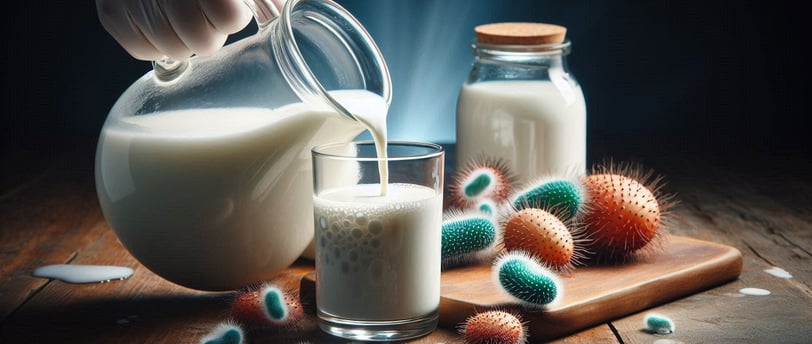Raw Milk, Live Bacteria
The consumption of unpasteurised milk poses serious health risks
MEDICAL NUTRITION
Dr. Simon Miller Ph.D.
8/30/20244 min read


In recent years, an alarming trend for raw foods has been gaining momentum. Raw (unpasteurised) milk has become a fad diet and big business. These two terms “fad diet” and “big business” immediately conjure thoughts of pseudo-science and scams, respectively. Typically, people who promote fad diets are either uneducated or unscrupulous get-rich-quick types.
There is very little scientific evidence to support the consumption of raw milk, and any such evidence is generally biased. For example, some low-level scientists have a hypothesis and then stick to that theme whether the data supports it or not. By cherry-picking positive data and omitting negative data, it is easy to construct a one-sided manuscript that aligns with popular or political opinion. Also, many biased manuscripts have a conflict of interest such as funding from a company, or a business interest in the same product or field of research. This is very bad scientific practice.
So, what do raw milk advocates claim are the health benefits of unpasteurised milk? Well, they claim that raw milk contains healthy bacteria such as Lactobacilli, which can modify the gut microbiota and influence physical and psychological health. There are even unfounded claims regarding disease prevention including reduced cancer rates. I would like to make it very clear that such claims have no scientific foundation. It is also claimed that pasteurisation damages nutrients in milk.
In reality, raw milk can contain various types of pathogenic bacteria, including Campylobacter, Listeria, Cryptosporidium, Escherichia coli, Salmonella, and many more. Milk is a rich medium for microbial growth – consider how a glass of milk begins to smell after a few hours, and how spilt milk becomes rancid after a couple of days. On a practical note, it is obvious that a cow shed is not a sterile environment, and it is very easy for milking machines to become contaminated. Cows’ teats and workers’ gloves are not clean, so handling of machinery and teats is an avenue for contamination. Not to mention the fact that there is faecal matter all around the animals and machinery. Also, how well does an average dairy farm employee (perhaps earning minimum wage) clean the animals’ teats, machinery, and machine attachments? Taken together, milk can easily become contaminated.
Infections from raw-milk consumption can result in mild to serious illness, hospitalisation, and, in some cases, death. Furthermore, even after recovery, deleterious health effects can linger for years. Gut microbiota can also be subjected to long-term alterations with possible implications in other health conditions such as inflammatory bowel disease (see “What’s New in IBD” blog). Moreover, even in the absence of noticeable symptoms of infection, low-level contamination of raw milk with pathogenic microbes and subsequent consumption can affect the microbiota and upregulate inflammatory and immune responses. Such long-term, low-scale inflammation can be a driver of cancer and other diseases.
It is also important to think about the health of animals too. Cows often become sick and require medical treatment, frequently with antibiotics. Milk is easily contaminated with medication, and the presence of antibiotics in milk can generate antibiotic-resistant bacterial species. Without pasteurisation to kill bacteria, raw milk can become a source of antibiotic-resistant bacteria that can colonise the gut when consumed. This can lead to more dangerous infections that are more difficult to treat. Moreover, antibiotic resistance in bacteria can lead to multi-drug resistance, which is especially dangerous in immunocompromised individuals such as cancer patients.
It is true that pasteurisation can induce chemical modifications to some nutrients, but it is very minor. For example, sulphur-containing amino acids can become oxidised leading to the formation of sulphides that give rise to that characteristic taste of ultra-high temperature (UHT, long-life) milk. Even so, the level of methionine oxidation is low in UHT milk. In regular pasteurised milk, the level of oxidised methionine is lower. This oxidation does not impact pasteurised milk’s chemical score or biological availability. Moreover, milk is consumed as part of a balanced diet where nutrients from various sources are pooled for biological activity or synthesis.
In summary, raw milk should never be consumed. There are few to no health benefits, and it poses a serious health risk. In particular, pregnant and lactating women, infants, children, elderly people, and immunocompromised individuals must not consume raw milk. This trend is not based on science and is dangerous. Influencers and businesses that promote raw-milk consumption are only doing so out of ignorance and for financial gain. It is better not to put money in the pockets of individuals and companies that are willing to endanger public health.
For the ultimate science-based nutritional guide for overall good health, please refer to the OneLife Diet Meal Plan (eBook). Take control of your health today.
Further reading:
OneLife Diet Meal Plan: Total Nutritional Guide. Link
Foodborne illness outbreaks linked to unpasteurised milk and relationship to changes in state laws – United States, 1998–2018. Link
Campylobacteriosis associated with the consumption of unpasteurised milk: findings from a sentinel surveillance site. Link
Whole-Genome Sequencing of Gram-Negative Bacteria Isolated From Bovine Mastitis and Raw Milk: The First Emergence of Colistin mcr-10 and Fosfomycin fosA5 Resistance Genes in Klebsiella pneumoniae in Middle East. Link
CDC Food Safety: Raw Milk. Link
Recipe for a Healthy Gut: Intake of Unpasteurised Milk Is Associated with Increased Lactobacillus Abundance in the Human Gut Microbiome. Link. Important note: This is a very biased and low-level publication. The authors had a conflict of interest by promoting their organic farm and cookery course, which included unpasteurised milk. Publications such as this one are a discredit to science and are tantamount to misinformation. I included this publication to highlight the importance of high-level scientific understanding when it comes to nutrition and medical health. In science and medicine, it is critical to reference multiple, reputable sources for accurate and unbiased understanding.


